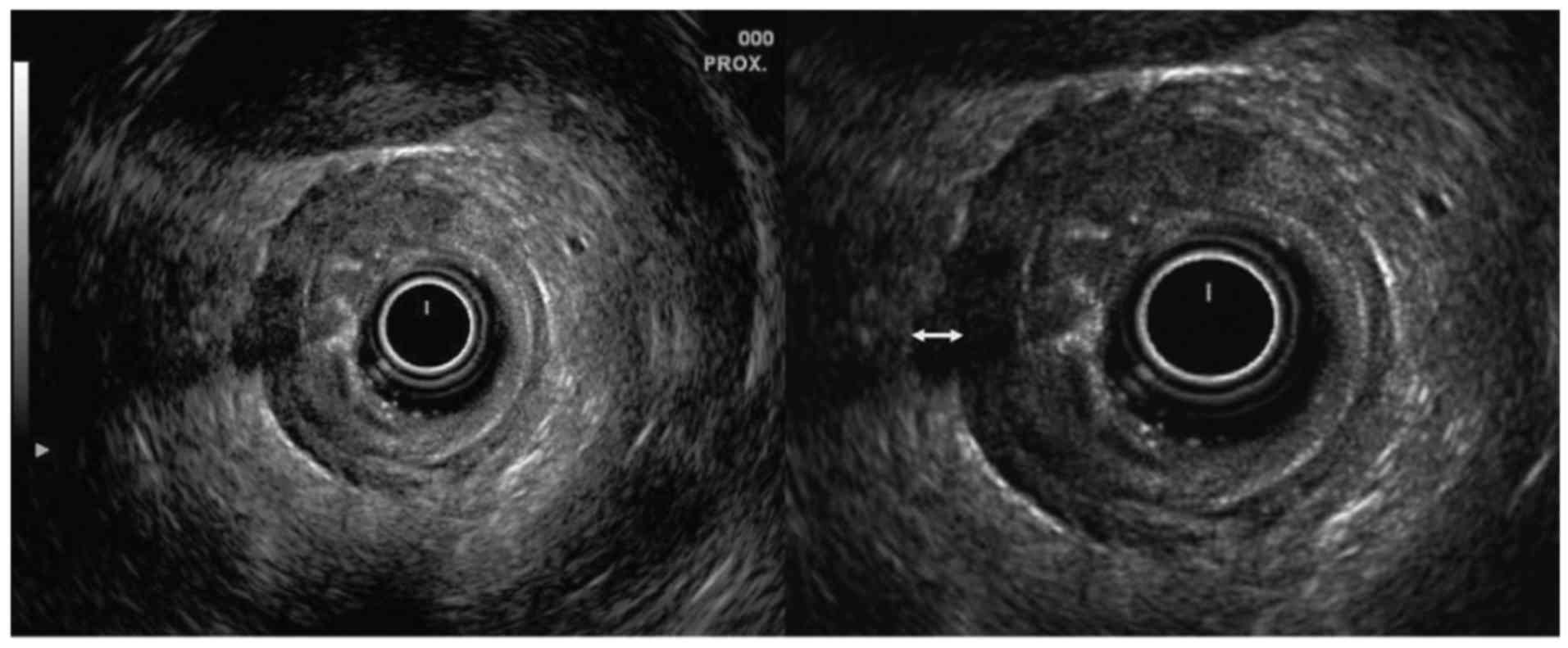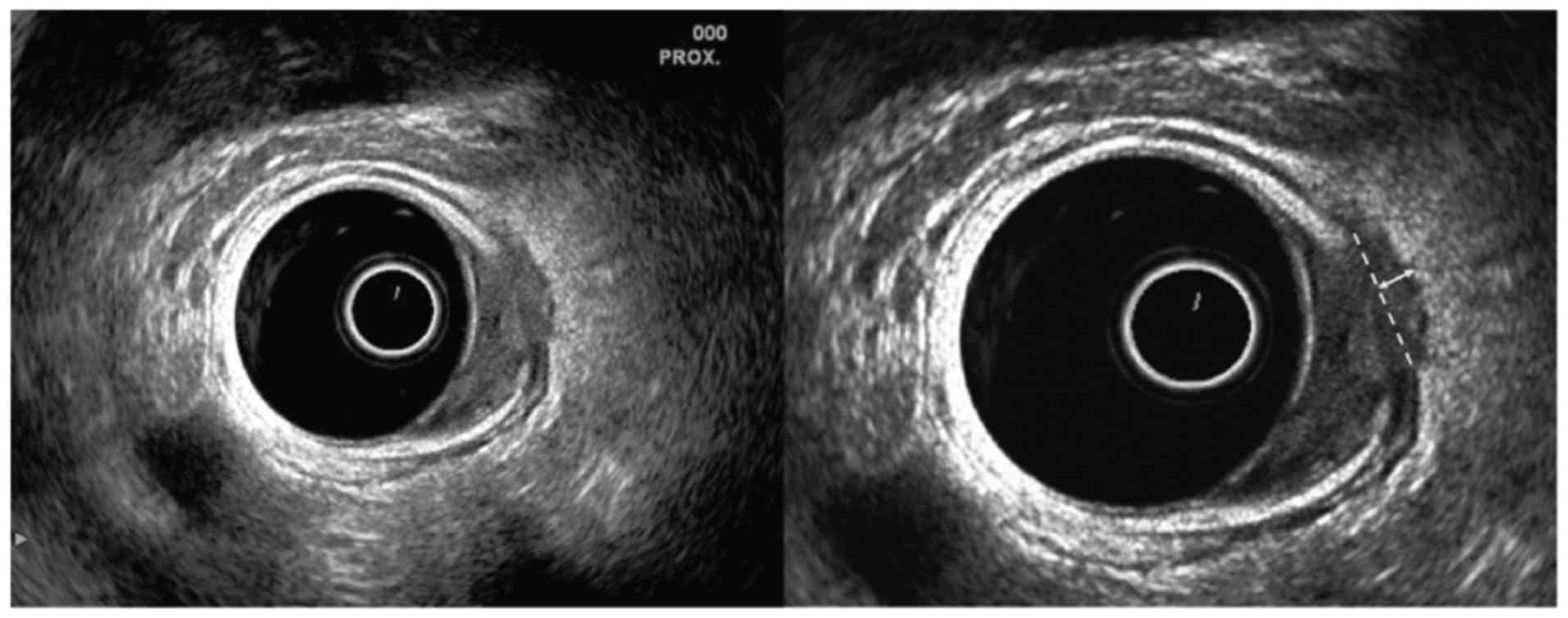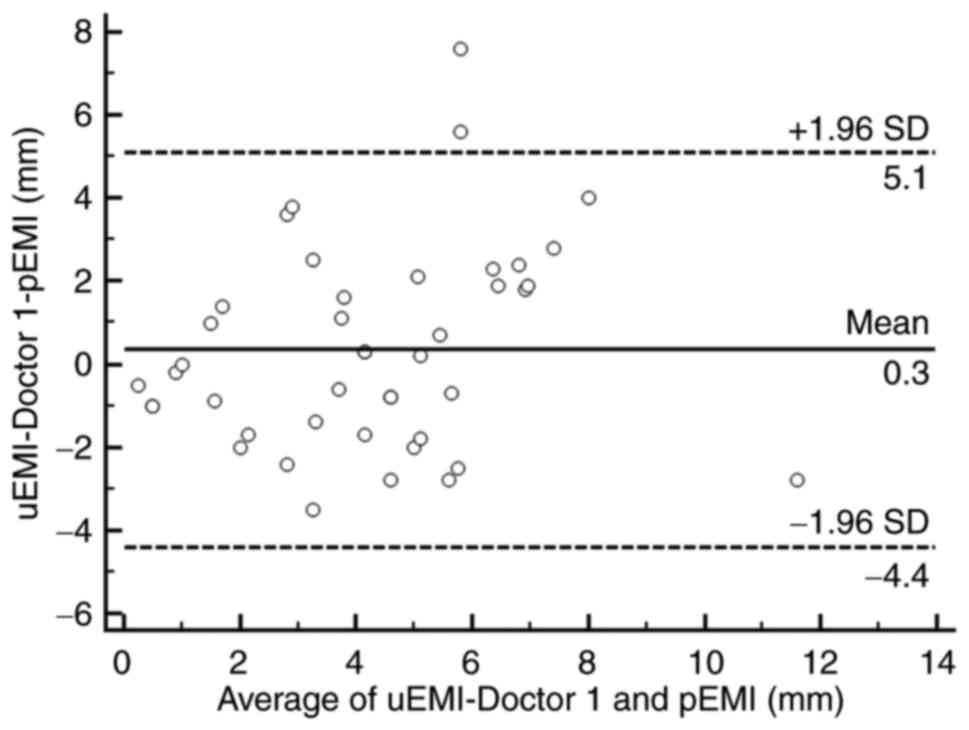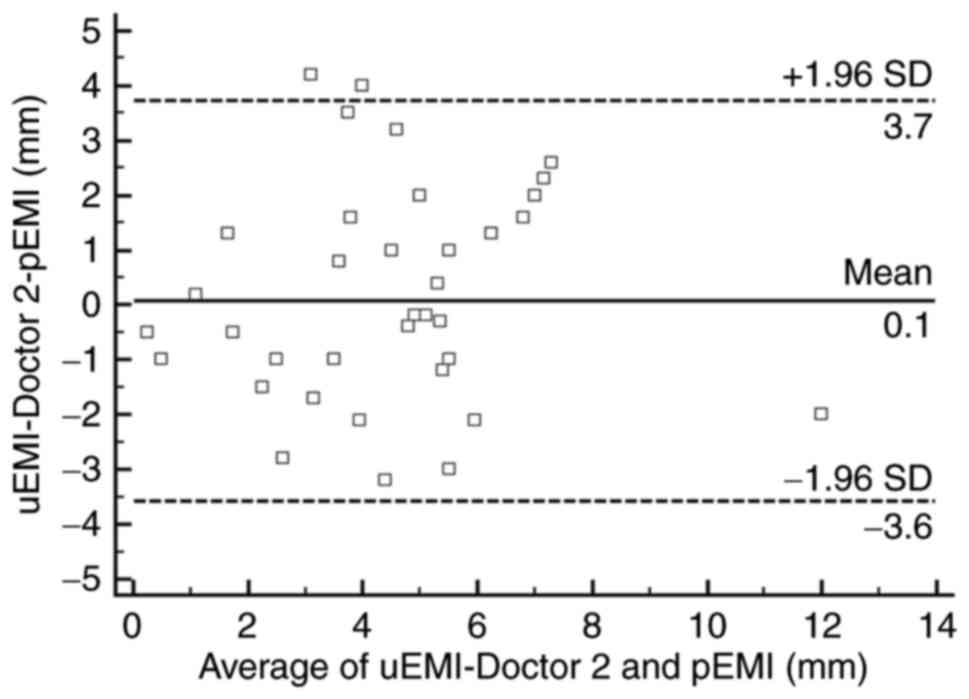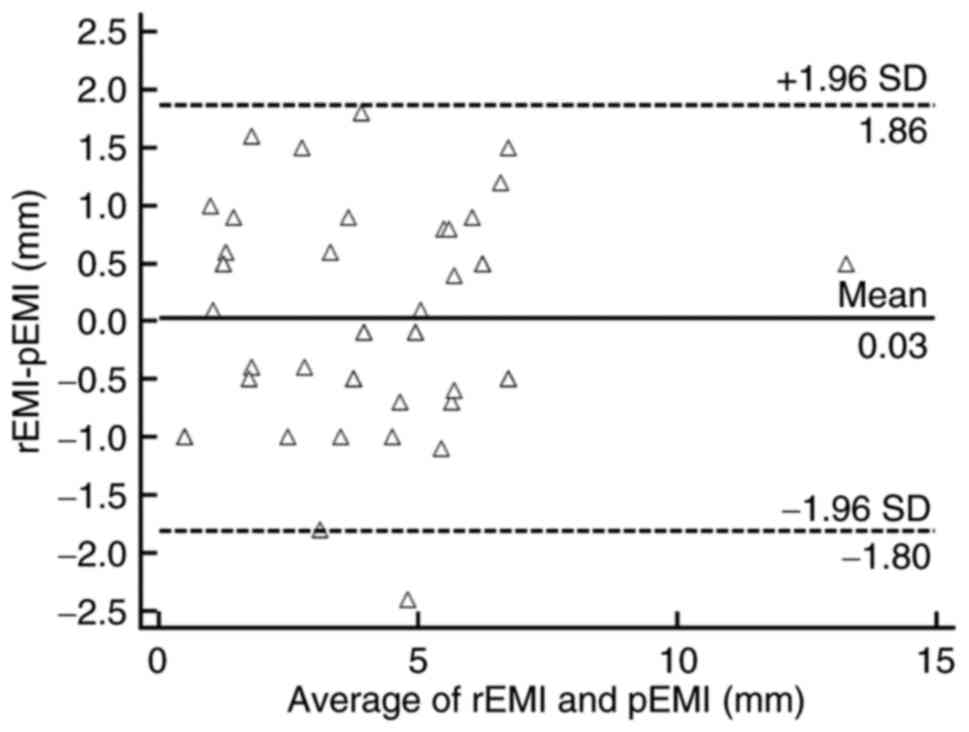Value of endorectal ultrasonography in measuring the extent of mesorectal invasion and substaging of T3 stage rectal cancer
- Authors:
- Published online on: September 6, 2017 https://doi.org/10.3892/ol.2017.6906
- Pages: 5657-5663
Abstract
Introduction
In recent years, the incidence of rectal cancer has risen. In addition, about 60% of rectal cancer cases are in advanced stages at diagnosis. Neoadjuvant chemoradiotherapy is the standard treatment for advanced rectal cancer, and chemoradiotherapy can effectively reduce the tumor size, increase the rates of successful resection and sphincter preservation, and reduce the local recurrence rate (1,2). However, complications of concurrent chemoradiotherapy, such as fecal incontinence, urinary incontinence, and sexual dysfunction, cannot be ignored (3–5).
Individualized therapy is the current trend in the diagnosis and treatment of rectal cancer (6). It is proposed that T3 patients with early microinvasion do not require neoadjuvant chemotherapy (7,8). Many studies have found that the extent of mesorectal invasion (EMI) is a significant independent prognostic factor for T3 rectal cancer (9–12). The MERCURY study showed that rectal cancer patients with an EMI ≤5 mm (pT3a) had a better prognosis than those with an EMI >5 mm (pT3b) (13). When the EMI was <5 mm, total mesorectal excision was sufficient to ensure complete tumor resection, and thus, the complications of chemoradiotherapy could be avoided. Thus, determination of substages within the T3 stage based on the EMI is very important for predicting prognosis and treatment planning. However, the currently used pre-operative TNM staging based on radiographic data is insufficient to meet the clinical needs. More prognostic information is needed, such as the EMI, circumferential resection margin (CRM), and so on.
Currently, the EMI assessed by magnetic resonance imaging (MRI) is typically used for substaging of T3 rectal cancer, and the accuracy of this approach has been confirmed by multiple studies (13,14). Endorectal ultrasound (ERUS) has advantages in TN staging over MRI, such as higher accuracy, lower cost, and easier operation (15). However, the value of ERUS in assessing the EMI has not been widely recognized (16–18).
The present study aimed to assess the consistency between ultrasound and pathological measurements of EMI as well as to assess interobserver agreement for EMI measurements. In addition, the accuracy of ERUS and MRI in T3 and substaging of T3 rectal cancer were compared, so as to demonstrating the role of ERUS in the treatment of T3 rectal cancer.
Patients and methods
Patients
We retrospectively analyzed the clinical data of rectal cancer patients admitted to Peking Union Medical College Hospital between January 2014 and July 2015. The clinical pathological and imaging data were retrieved. This study was approved by the Peking Union Medical College Hospital Ethics Committee.
The inclusion criteria included: i) histologically (biopsy) confirmed rectal carcinoma; ii) did not receive neoadjuvant chemoradiotherapy before surgery; iii) achieved radical resection in accordance with the principles of total mesorectal excision (TME), as the removal en bloc of the tumor together with its mesorectum; iv) both ERUS and MRI were performed before surgery, v) complete ERUS with dynamic imaging for 120s continuously; vi) tumor located <10 cm above the anal verge, and vii) tumor not causing intestinal stenosis.
ERUS imaging and interpretation
Ultrasound was performed on a Hitachi Vision Preirus ultrasound machine, equipped with a EUP-R54AW-33 endorectal probe, with the frequency of 5–10 MHz and a scanning angle of 360°. Two doctors conducted TN staging and EMI measurements independently. Dynamic US images were retrieved from the imaging workstation. The Hildebrandt uTN classification was used for ERUS staging of tumors (19). The best images on which the EMI was measured were selected according to the following criteria: i) probe was located at the center of the intestine; and ii) maximum diameter of tumor invasion was shown. There is currently no accepted method for the measurement of the EMI by ERUS, and with reference to MRI measurement methods (20), the following ERUS measurement methods were created. If the muscularis propria was completely identifiable, the maximum distance from the deepest part of tumor invasion to the outer border of the muscularis propria was measured (Fig. 1); if the muscularis propria was not entirely identifiable, the maximum distance from the deepest part of tumor invasion to an imaginary line connecting two break points of the muscularis propria was measured (Fig. 2).
Magnetic resonance imaging and interpretation
One experienced radiologist who had no previous information concerning the clinical or pathologic findings, interpreted whole MRI scans on the PACS viewer regarding T and N stages. The extent of mesorectal invasion was measured blindly to the ERUS findings in this study, with special focus on the thin slice axial T2 weighted MRI images. The EMI in millimeters was measured in the same manner as the ERUS measurement.
T3 substaging of rectal cancer by ERUS and MRI
In T3 substaging, there is currently no cut-off point for the EMI measured by ERUS. Based on a previous study (13), 5 mm was set as the cut-off point, and T3 stage was divided into u, rT3a stage (u, rEMI ≤5 mm) and u, rT3b stage (u, rEMI >5 mm).
Pathological measurement and staging
An experienced pathologist was in charge of the pathological measurement and staging. For all the specimens, the intestine was opened along the opposite side of the mesentery. Specimens were fixed for at least 12 h in 10% formalin. Then the deepest point of tumor infiltration was selected, and one or more sections were made and subdivided into appropriately sized pieces. Specimens were embedded in paraffin and stained with hematoxylin-eosin, and then the pEMI was measured. The pathologist measured the distance between the outer border of the identifiable muscularis propria and the outermost border of the tumor. When the muscularis propria could not be identified, an imaginary line connecting two break points of the muscularis propria was used. A 5-mm cut-off value was used for categorizing pT3 stage specimens into pT3a and pT3b.
The pathological staging results were considered as the gold standard, and the sensitivity, specificity, and accuracy of ERUS and MRI for T3 rectal cancer and substaging of T3 rectal cancer were assessed.
Statistical analysis
The MedCalc11.4.2.0 statistical package was used for statistical analysis. Data are expressed as mean ± standard deviation. The TN staging and subT3 staging by ERUS and MRI were compared with the pathological findings, considered as the criterion standard. The consistency between the measurement of EMI by ERUS and MRI and pathological measurement were evaluated using the Bland-Altman analysis. The intraclass correlation coefficient (ICC) was calculated by a two-factor random effects model to assess the consistency of measurements between two ultrasound doctors. An ICC >0.80 indicates good consistency, 0.61–0.80 medium consistency, 0.41–0.60 moderate consistency, 0.21–0.40 poor consistency, and ≤0.20 no consistency. The accuracy of ERUS and MRI in substaging of T3 tumors were compared by using the χ2 test. P-values less than 0.05 were considered significant.
Results
Basic characteristics
According to the inclusion criteria, 61 patients with different stages of rectal cancer were enrolled in the study, including 35 males and 26 females with a mean age of 54. 36±10.93 years (range, 30–82 years). Radical resection in accordance with the principles of TME was achieved for all patients. Laparoscopic resection was performed in 46 cases, and open surgery was performed in 15 cases. Postoperative chemotherapy was performed in seven cases. Patient characteristics are summarized in Table I.
Accuracy of MRI and ERUS in TN staging
The MRI correctly staged the depth of rectal wall invasion in 49 cases, for an overall accuracy rate of 80.3% (49/61). MRI understaged the depth in two cases and overstaged it in ten. Two pT3 tumors were understaged as rT2. Six pT1 tumors were overstaged as rT2 tumors and four pT2 tumors were overstaged as rT3 (Table I). MRI correctly predicted the N stage in 48 cases, for an overall accuracy rate of 78.7% (48/61). MRI overstaged the N stage in three cases and understaged it in 10.
The accuracies of ERUS in T stage by the two ultrasound doctors were 85.2% (52/61) and 81.9% (50/61), respectively. The first doctor overstaged six cases and understaged three cases. The second doctor overstaged six cases and understaged five cases. They mainly overstaged pT2 tumors as uT3 tumors. The two doctors correctly predicted the N stage in 46 cases and 43 cases, respectively. The first doctor overstaged four cases and understaged 11 cases. The second doctor overstaged five cases and understaged 13 cases. The TN stage by MRI and ERUS are summarized in Tables II and III.
Reliability of EMI measurements by ERUS and interobserver agreement
Two doctors measured the EMI on ERUS, and the average uEMI values were 4.8±2.7 mm (0.8–10.2 mm) and 4.6±2.3 mm (1.2–11 mm) for doctors 1 and 2, respectively. The average pEMI value was 4.1±2.4 mm (0.5–12.5 mm). As shown in the Bland-Altman scatter plots (Figs. 3 and 4), most of the plotted points were located within the range of mean ± 1.96 SD, showing that the ERUS measurements and pathology measurements were in good agreement. The arithmetic mean difference between the ERUS measurement and pathology measurement was 0.3 mm (95% confidence interval [CI], −0.397–1.094 mm) for doctor 1 and 0.1 mm (95% CI, −0.493–0.651 mm) for doctor 2. The 95% CIs of the limits of agreement were 5.1 mm (95% CI, 3.815–6.384 mm) to −4.4 mm (95% CI, −5.686 to −3.117 mm) for doctor 1 and 37 mm (95% CI, 2.739–4.710 mm) to −3.5 mm (95% CI, −4.552 to −2.581 mm) for doctor 2.
The interobserver agreement for uEMI measurements between the two doctors was good (ICC=0.9344; 95% CI, 0.8789–0.9645).
Reliability of EMI measurements by MRI
The Bland-Altman plot showed that most plotted points were located within the mean ±1.96 SD, which indicates good agreement (Fig. 5). The average value of rEMI was 4.3±2.4 mm. The arithmetic mean difference between the MRI measurement and pathology measurement was 0.03 mm (95% CI, −0.397–1.094 mm). The 95% CIs of the limits of agreement were 1.9 mm (95% CI, 1.365–2.356 mm) to −1.8 mm (95% CI, −2.301 to −1.309 mm).
Efficacy of ERUS and MRI for T3 and T3 substaging of rectal cancer
The diagnostic accuracy, sensitivity, and specificity for the two individual doctors for the diagnosis of T3 rectal cancer were 86.9% (53/61), 93.0% (40/43), and 72.2% (13/18) compared with 85.2% (52/61), 88.4 (38/43), and 77.8% (14/18), respectively. The diagnostic accuracy, sensitivity, and specificity of MRI for the diagnosis of T3 rectal cancer were 90.2% (55/61), 95.3% (41/43), and 77.8% (14/18), respectively.
We used 5 mm as the cut-off value for the EMI for substaging of T3 rectal cancer. The accuracies of substaging T3 rectal cancer made by the two doctors were 79.1% (37/43) and 67.4% (31/43). The accuracy of MRI in substaging T3 rectal cancer was 86.0% (37/43). Though it was obviously much higher than those of ERUS, there was no significantly statistical difference among them (P=0.394>0.05; P=0.112>0.05). The detailed diagnostic accuracy, sensitivity, and specificity values are summarized in Table IV.
Discussion
This is the first study to compare EMI measurements determined by ERUS and pathology measurements. Currently, the value of ERUS in measuring the EMI has not been widely recognized. ERUS has been used to measure the EMI and for substaging of T3 rectal cancer (16), but the reliability of ultrasound measurements of the EMI has not been evaluated. This study verified the reliability of ERUS for measuring the EMI. The Bland-Altman scatter plot showed good consistency between ultrasound and pathology measurements. Meanwhile, the good agreement between uEMI measurements made by two ultrasound doctors also suggests the promising clinical potential of this method.
Among the imaging methods used for staging, MRI is now the preferred technique for EMI assessment, and its reliability has been demonstrated (21). In the present study, it was demostrated that MRI was a reliable method for the measurement of EMI, and the accuracy of T3 and T3 substaging was also high. ERUS was more accurate than MRI for the evaluation of local invasion, especially for T1 and T2 tumors, our study also demonstrated that ERUS was superior in diagnosis T1 tumor. In recent years, there has been a shift away from ERUS for the staging of rectal cancer. This can be partially explained by factors linked to ERUS such as the reported low accuracy in the staging of advance rectal cancer in some recent studies and the operator dependency. In addition, MRI can be used to assess the circumferential resection margin and EMI which are the most important prognostic factors with regard to TN stage.
However, MRI has some shortcomings, such as high cost and long exam duration. Moreover, there are many MRI contraindications; for example, patients with a pacemaker, intrauterine device, or claustrophobia are not suitable for MRI (21). Compared to MRI, ERUS has the following advantages: Low cost, fewer contraindications, and easy operation. Although ERUS is less accurate in substaging of T3 tumor than MRI, ERUS can overcome the shortcomings of MRI in preoperative stage of T3 rectal cancer. For complementary to each other, MRI and ERUS should be used together so as to selecting the best therapeutical approach.
Maximal tumor thickness (MTT) also has been used for substaging. Esclapez et al divided the T3 stage into uT3a (uMTT ≤19 mm) and uT3b (uMTT >19 mm) (22). They believed that because the muscularis propria was replaced by tumor, the ERUS would be unlikely to clearly show the muscularis propria. Thus, the measurement of the EMI would suffer from errors. However, our previous study (23) demonstrated that the vast majority of patients have an uMTT >19 mm, and therefore, if we use 19 mm as the cut-off point, many patients with a high risk of local recurrence might be missed, resulting in insufficient treatment. In the present study, the average errors of the uEMI were 0.3 and 0.1 mm, which are acceptable. In addition, when most of the tumor protrudes into the intestine lumen, MTT is not a good indicator of tumor aggressiveness. By contrast, the EMI can more directly reflect the tumor aggressiveness as well as the prognosis, and thus, the EMI is a preferred indicator for substaging of T3 rectal cancer.
Compared with the EMI measured by pathology, the uEMI showed some deviations. Possible reasons for these deviations includes: 1) it was difficult to choose the same section for both the ultrasound measurement and pathology measurement; 2) the muscularis propria may have been completely replaced by the tumor over a wide area, which could make measuring the EMI more difficult (21); 3) peritumoral inflammation and real transmural tumor extension cannot easily, reliably, or precisely distinguished on ultrasound, which commonly results in overestimation of the uEMI (24–26); and 4) bulky tumors can lie outside the focal length of the transducer (27).
There is no consensus on a cut-off value for the EMI for substaging T3 stage rectal cancer. Harewood et al divided T3 stage rectal cancer into minimally invasive T3 (EMI ≤2 mm) and advanced T3 (EMI >2 mm) substages (17). Rafaelsen et al divided T3 stage rectal cancer into four substages according to UICC standards: T3a (EMI: 0–1 mm), T3b (EMI: 2–5 mm), T3c (EMI: 5–15 mm), and T3d (EMI >15 mm). In their system T3a and T3b are considered early T3 stage rectal cancer, and T3c and T3d are considered advanced T3 rectal cancer (16). In this study, the uEMI in most cases was larger than 2 mm, and we also found that when the EMI was less than 2 mm, it was difficult to distinguish minor tumor infiltration from paraneoplastic fibrosis and inflammation. In this study, with 5 mm as the cut-off value for classifying the uEMI measurements, substaging of T3 rectal cancer showed good consistency with the pathology results.
To identify an effective strategy for the treatment of T3 rectal cancer, we need to accurately evaluate the prognostic factors preoperatively and assess the risk of recurrence, before a specific, individual treatment plan can be formulated. Another important factor in determining the prognosis of T3 rectal cancer is the CMR. Residual tumor in CRM was found to be related to a high risk of local recurrence, and thus, patients with positive CRM need to be treated with neoadjuvant chemoradiotherapy (28). ERUS was once considered to offer limited resolution and visualization ability, and it could not clearly show the mesorectal fascia. Thus, it has not been a conventional method used for pre-operative assessment of CRM. Phang first reported that ERUS can be used for the diagnosis of CRM (29), and then another study reported the diagnostic accuracy of ERUS for CRM is 83.7% (30). In addition, our previous studies demonstrated an accuracy of 98.1% and a negative predictive value of 100% for ERUS (23). ERUS can not only be applied to TN staging, but also can provide information on the EMI, CRM, and location of the tumor. This information is helpful for predicting the prognosis and planning treatment. For example, when the EMI is greater than 5 mm, the lymph node status is N2 stage, more than 4 lymph nodes are involved, CRM is positive, and lesions are in the lower section of the rectum, the risks for local recurrence and distant metastasis are extremely high, and preoperative neoadjuvant therapy should be selected.
The present study has some limitations. First, this was a retrospective study, and therefore, the data analyses are prone to bias. Second, in the present study the frequency of the probe was not fixed, which may have some impact on the diagnostic accuracy. The resolution of a 5.0 MHz endorectal transducer is high, which may be approximately the same or higher as the resolution for thin slice axial T2 weighted MRI. Further study will be need to demonstrate this.
ERUS is a valuable tool for measurement of the EMI, and a cut-off point of 5 mm can be used for substaging of T3 rectal cancer. ERUS and MRI can be used together which will be quite helpful for selecting appropriate treatments for rectal cancer patients.
References
|
Berardi R, Maccaroni E, Onofri A, Morgese F, Torniai M, Tiberi M, Ferrini C and Cascinu S: Locally advanced rectal cancer: The importance of a multidisciplinary approach. World J Gastroenterol. 20:17279–17287. 2014. View Article : Google Scholar : PubMed/NCBI | |
|
Marks J, Nassif G, Schoonyoung H, DeNittis A, Zeger E, Mohiuddin M and Marks G: Sphincter-sparing surgery for adenocarcinoma of the distal 3 cm of the true rectum: Results after neoadjuvant therapy and minimally invasive radical surgery or local excision. Surg Endosc. 27:4469–4477. 2013. View Article : Google Scholar : PubMed/NCBI | |
|
Loos M, Quentmeier P, Schuster T, Nitsche U, Gertler R, Keerl A, Kocher T, Friess H and Rosenberg R: Effect of preoperative radio(chemo)therapy on long-term functional outcome in rectal cancer patients: A systematic review and meta-analysis. Ann Surg Oncol. 20:1816–1828. 2013. View Article : Google Scholar : PubMed/NCBI | |
|
Bruheim K, Guren MG, Dahl AA, Skovlund E, Balteskard L, Carlsen E, Fosså SD and Tveit KM: Sexual function in males after radiotherapy for rectal cancer. Int J Radiat Oncol Biol Phys. 76:1012–1017. 2010. View Article : Google Scholar : PubMed/NCBI | |
|
Bruheim K, Guren MG, Skovlund E, Hjermstad MJ, Dahl O, Frykholm G, Carlsen E and Tveit KM: Late side effects and quality of life after radiotherapy for rectal cancer. Int J Radiat Oncol Biol Phys. 76:1005–1011. 2010. View Article : Google Scholar : PubMed/NCBI | |
|
Wilson PM, Ladner RD and Lenz HJ: Exploring alternative individualized treatment strategies in colorectal cancer. Clin Colorectal Cancer. 7 Suppl 1:S28–S36. 2007. View Article : Google Scholar : PubMed/NCBI | |
|
Cecil TD, Sexton R, Moran BJ and Heald RJ: Total mesorectal excision results in low local recurrence rates in lymph node-positive rectal cancer. Dis Colon Rectum. 47:1145–1150. 2004. View Article : Google Scholar : PubMed/NCBI | |
|
Frasson M, Garcia-Granero E, Roda D, Flor-Lorente B, Roselló S, Esclapez P, Faus C, Navarro S, Campos S and Cervantes A: Preoperative chemoradiation may not always be needed for patients with T3 and T2N+ rectal cancer. Cancer. 117:3118–3125. 2011. View Article : Google Scholar : PubMed/NCBI | |
|
Cawthorn SJ, Parums DV, Gibbs NM, A'Hern RP, Caffarey SM, Broughton CI and Marks CG: Extent of mesorectal spread and involvement of lateral resection margin as prognostic factors after surgery for rectal cancer. Lancet. 335:1055–1059. 1990. View Article : Google Scholar : PubMed/NCBI | |
|
Willett CG, Badizadegan K, Ancukiewicz M and Shellito PC: Prognostic factors in stage T3N0 rectal cancer: Do all patients require postoperative pelvic irradiation and chemotherapy? Dis Colon Rectum. 42:167–173. 1999. View Article : Google Scholar : PubMed/NCBI | |
|
Steel MC, Woods R, Mackay JM and Chen F: Extent of mesorectal invasion is a prognostic indicator in T3 rectal carcinoma. ANZ J Surg. 72:483–487. 2002. View Article : Google Scholar : PubMed/NCBI | |
|
Miyoshi M, Ueno H, Hashiguchi Y, Mochizuki H and Talbot IC: Extent of mesorectal tumor invasion as a prognostic factor after curative surgery for T3 rectal cancer patients. Ann Surg. 243:492–498. 2006. View Article : Google Scholar : PubMed/NCBI | |
|
Merkel S, Mansmann U, Siassi M, Papadopoulos T, Hohenberger W and Hermanek P: The prognostic inhomogeneity in pT3 rectal carcinomas. Int J Colorectal Dis. 16:298–304. 2001. View Article : Google Scholar : PubMed/NCBI | |
|
MERCURY Study Group: Extramural depth of tumor invasion at thin-section MR in patients with rectal cancer: Results of the MERCURY study. Radiology. 243:132–139. 2007. View Article : Google Scholar : PubMed/NCBI | |
|
Marone P, de Bellis M, D'Angelo V, Delrio P, Passananti V, Di Girolamo E, Rossi GB, Rega D, Tracey MC and Tempesta AM: Role of endoscopic ultrasonography in the loco-regional staging of patients with rectal cancer. World J Gastrointest Endosc. 7:688–701. 2015.PubMed/NCBI | |
|
Rafaelsen SR, Vagn-Hansen C, Sørensen T, Pløen J and Jakobsen A: Transrectal ultrasound and magnetic resonance imaging measurement of extramural tumor spread in rectal cancer. World J Gastroenterol. 18:5021–5026. 2012. View Article : Google Scholar : PubMed/NCBI | |
|
Harewood GC, Kumar KS, Clain JE, Levy MJ and Nelson H: Clinical implications of quantification of mesorectal tumor invasion by endoscopic ultrasound: All T3 rectal cancers are not equal. J Gastroenterol Hepatol. 19:750–755. 2004. View Article : Google Scholar : PubMed/NCBI | |
|
Muñoz E, Granero-Castro P, Frasson M, Escartin J, Esclapez P, Campos S, Flor-Lorente B and Garcia-Granero E: Modified Wong's classification improves the accuracy of rectal cancer staging by endorectal ultrasound and MRI. Dis Colon Rectum. 56:1332–1338. 2013. View Article : Google Scholar : PubMed/NCBI | |
|
Hildebrandt U and Feifel G: Preoperative staging of rectal cancer by intrarectal ultrasound. Dis Colon Rectum. 28:42–46. 1985. View Article : Google Scholar : PubMed/NCBI | |
|
Cho SH, Kim SH, Bae JH, Jang YJ, Kim HJ, Lee D and Park JS: Society of North America (RSNA): Prognostic stratification by extramural depth of tumor invasion of primary rectal cancer based on the Radiological Society of North America proposal. AJR Am J Roentgenol. 202:1238–1244. 2014. View Article : Google Scholar : PubMed/NCBI | |
|
Kim YW, Cha SW, Pyo J, Kim NK, Min BS, Kim MJ and Kim H: Factors related to preoperative assessment of the circumferential resection margin and the extent of mesorectal invasion by magnetic resonance imaging in rectal cancer: A prospective comparison study. World J Surg. 33:1952–1960. 2009. View Article : Google Scholar : PubMed/NCBI | |
|
Esclapez P, Garcia-Granero E, Flor B, Garcia-Botello S, Cervantes A, Navarro S and Lledó S: Prognostic heterogeneity of endosonographic T3 rectal cancer. Dis Colon Rectum. 52:685–691. 2009. View Article : Google Scholar : PubMed/NCBI | |
|
Zhong G, Xiao Y, Zhang J, Dai Q, Li J and Jiang Y: Value of endorectal ultasound in predicting the circumferential resection margin and maximum tumor thickness of T3 rectal cancer. Zhonghua Wei Chang Wai Ke Za Zhi. 18:252–256. 2015.(In Chinese). PubMed/NCBI | |
|
Siddiqui AA, Fayiga Y and Huerta S: The role of endoscopic ultrasound in the evaluation of rectal cancer. Int Semin Surg Oncol. 3:362006. View Article : Google Scholar : PubMed/NCBI | |
|
Assenat E, Thézenas S, Samalin E, Bibeau F, Portales F, Azria D, Quenet F, Rouanet P, Aubert Saint B and Senesse P: The value of endoscopic rectal ultrasound in predicting the lateral clearance and outcome in patients with lower-third rectal adenocarcinoma. Endoscopy. 39:309–313. 2007. View Article : Google Scholar : PubMed/NCBI | |
|
Bipat S, Glas AS, Slors FJ, Zwinderman AH, Bossuyt PM and Stoker J: Rectal cancer: Local staging and assessment of lymph node involvement with endoluminal US, CT and MR imaging-a meta-analysis. Radiology. 232:773–783. 2004. View Article : Google Scholar : PubMed/NCBI | |
|
Fernández-Esparrach G, Ayuso-Colella JR, Sendino O, Pagés M, Cuatrecasas M, Pellisé M, Maurel J, Ayuso-Colella C, González-Suárez B, Llach J, et al: EUS and magnetic resonance imaging in the staging of rectal cancer: A prospective and comparative study. Gastrointest Endosc. 74:347–354. 2011. View Article : Google Scholar : PubMed/NCBI | |
|
Burton S, Brown G, Daniels IR, Norman AR, Mason B and Cunningham D: Royal Marsden Hospital, Colorectal Cancer Network: MRI directed multidisciplinary team preoperative treatment strategy: The way to eliminate positive circumferential margins? Br J Cancer. 94:351–357. 2006. View Article : Google Scholar : PubMed/NCBI | |
|
Phang PT, Gollub MJ, Loh BD, Nash GM, Temple LK, Paty PB, Guillem JG and Weiser MR: Accuracy of endorectal ultrasound for measurement of the closest predicted radial mesorectal margin for rectal cancer. Dis Colon Rectum. 55:59–64. 2012. View Article : Google Scholar : PubMed/NCBI | |
|
Granero-Castro P, Munoz E, Frasson M, Garcia-Granero A, Esclapez P, Campos S, Flor-Lorente B and Garcia-Granero E: Evaluation of mesorectal fascia in mid and low anterior rectal cancer using endorectal ultrasound is feasible and reliable: A comparison with MRI findings. Dis Colon Rectum. 57:709–714. 2014. View Article : Google Scholar : PubMed/NCBI |



